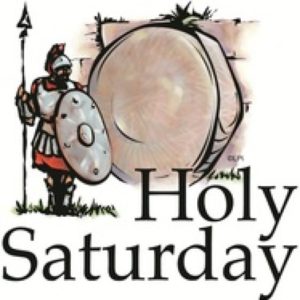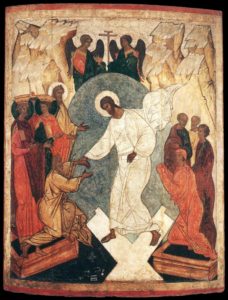 The Lord be with you
The Lord be with you
Holy Saturday is the Saturday before Easter Sunday. This is the day our Lord rested in the garden tomb. Easter morning he will burst the chains of death and rise from the grave. As I grew up, the theological significance of Holy Saturday was not explored much in my church. I suspect that was true in most Lutheran churches. Today, though, more and more churches are recognizing Holy Saturday and often have an Easter Vigil service.
Perhaps the chief point about Holy Saturday is that every aspect of our lives was experienced by Christ in order for him to redeem them, to sanctify them. He was conceived, born, baptized, grew-up, died and was buried. His rest in the tomb was the last aspect of his “humiliation,” that is, his complete identification with the human race. It was the last step in him “fulfilling all righteousness” (Matthew 3:15) for us. [You may wonder about marriage as Jesus did not marry. However he did experience family life, which is what marriage is all about, and he did sanctify marriage when he went to the marriage feast in Cana (John 2:1-12).] So on Holy Saturday Jesus sanctifies our rest in the grave, the last phase of our sinful earthly life. From our graves we will, like Jesus, rise in resurrection glory on the believers great “Easter” day, the Last Day, when Christ returns.
A growing number of churches have an Easter Vigil service on Holy Saturday. The full liturgy for such a vigil includes many Old Testament readings that are types of our Lord and would last three hours or longer. The service is intended to end after sunset so is really the first worship service of Easter Day. The Vigil service, therefore, ends with the reading of one of the Resurrection accounts and a benediction. It marks the end of the “Holy Triduum” (Holy Three Days). Many (most?) churches reduce the number of readings. The full liturgy also includes the lighting of the “new” fire, which is used to light candles for a candlelight portion of the service at the beginning. This is typically done outside the church building and the congregation progresses into the building.
Another aspect of Holy Saturday we might think of is Christ’s descent into hell. We confess this in the Apostles’ Creed. Concerning this, Article IX of the Formula of Concord, Solid Declaration, says:
 Even in the Ancient Christian teachers of the Church, as well as among some of our teachers, different explanations of the article about Christ’s descent to hell are found. Therefore, we abide in the simplicity of our Christian faith. Dr. Luther has pointed us to this in a sermon about Christ’s descent to hell, which he delivered in the castle at Torgau in the year 1533. In the Creed we confess, “I believe … in Jesus Christ, His only Son, our Lord, who … was crucified, died and was buried. He descended into hell.” In this Confession Christ’s burial and descent to hell are distinguished as different articles. We simply believe that the entire person (God and man) descended into hell after the burial, conquered the devil, destroyed hell’s power, and took from the devil all his might. We should not, however, trouble ourselves with high and difficult thoughts about how this happened. With our reason and our five senses this article can be understood as little as the preceding one about how Christ is placed at the right hand of God’s almighty power and majesty. We are simply to believe it and cling to the Word. So we hold to the substance and consolation that neither hell nor the devil can take captive nor the devil can take captive or injure us and all who believe in Christ.
Even in the Ancient Christian teachers of the Church, as well as among some of our teachers, different explanations of the article about Christ’s descent to hell are found. Therefore, we abide in the simplicity of our Christian faith. Dr. Luther has pointed us to this in a sermon about Christ’s descent to hell, which he delivered in the castle at Torgau in the year 1533. In the Creed we confess, “I believe … in Jesus Christ, His only Son, our Lord, who … was crucified, died and was buried. He descended into hell.” In this Confession Christ’s burial and descent to hell are distinguished as different articles. We simply believe that the entire person (God and man) descended into hell after the burial, conquered the devil, destroyed hell’s power, and took from the devil all his might. We should not, however, trouble ourselves with high and difficult thoughts about how this happened. With our reason and our five senses this article can be understood as little as the preceding one about how Christ is placed at the right hand of God’s almighty power and majesty. We are simply to believe it and cling to the Word. So we hold to the substance and consolation that neither hell nor the devil can take captive nor the devil can take captive or injure us and all who believe in Christ.
Concerning the descent, the three most commonly referenced biblical passages are 1 Peter 3:19, 1 Peter 4:6, and Ephesians 4:9. One aspect of the doctrine that troubles people is the question: “How can Jesus’ body lay three days in the grave and at the same time descend into Hell?” Concerning this we should remember that Jesus, because of the complete union between the human and divine natures, can and does do things physically that are beyond us. Therefore he can be physically in the Lord’s Supper. We might also note the words of Jesus to Nicodemus, “No one has ascended into heaven except him who descended from heaven, the Son of Man, who is in heaven” (John 3:13). Notice that Jesus says that he is in heaven, even when he is sitting with Nicodemus. He can be at two places at the same time. We see this also in the resurrection accounts. While Jesus is walking with the Emmaus Road disciples, he is at the same time making other physical Easter Sunday appearances (Luke 24:13-35). This union of the divine and human in the person of Jesus is one of the great mysteries of the Christian Faith.
Prayer: O God, You made this most holy night to shine with the glory of the Lord’s resurrection. Preserve in us the spirit of adoption which You have given so that, made alive in body and soul, we may serve You purely; through Jesus Christ, Your Son, our Lord, who lives and reigns with You and the Holy Spirit, one God, now and forever. Amen.
Blessings in Christ,
Pastor John Rickert
If you like this post, why not share it?
